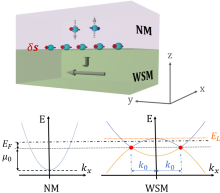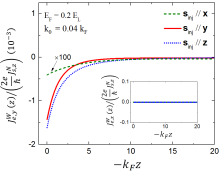Weyl semimetals (WSM) are a newly discovered class of quantum materials which can host a number of exotic transport properties in bulk. In this work, we investigate spin-to-charge conversion in magnetic WSMs, whereby a charge current is induced by injecting a spin current from an adjacent normal metal layer. Formally, the induced charge current is obtained by solving for the electronic scattering wave functions and the nonequilibrium distribution functions in each layer. We find that the charge current induced in magnetic WSMs exhibits strong anisotropy, arising from the unique band structure of the material that derives from its non-trivial topology.
We also determine the dependencies of the induced charge current on the position of the Fermi level as well as on the separation between the two Weyl nodes. The latter has no analogue in the spin-to-charge conversion effect studied previously in other materials, and hence provide extra knobs for controlling the effect in these topological semimetals. Our research opens the door to adding new functionalities to conventional electronic devices by utilizing topological quantum materials.
Steven S.-L. Zhang, Anton A. Burkov, Ivar Martin, and Olle G. Heinonen, Spin-to-charge conversion in magnetic Weyl semimetals, Phys. Rev. Lett. 123, 187201 (2019)


